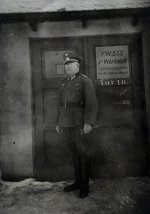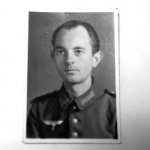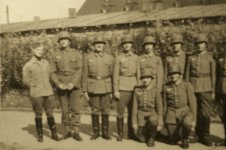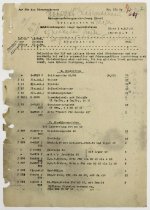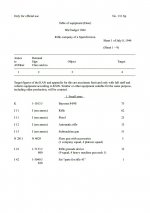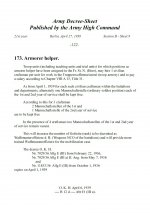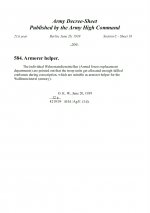Useful excerpts about soldiers disassembling K98k's, Waffenmeisters & field reworks
The following are excerpts from a recent thread on Gunboards that was deleted, some names changed. These facts are from our own member 8x57IS, and are useful postings:
The following, supplied by 8x57IS, were used in the book and are particularly interesting for this thread:
The following are excerpts from a recent thread on Gunboards that was deleted, some names changed. These facts are from our own member 8x57IS, and are useful postings:
(random member)In all my research I have never found a "regulation" that forbad German soldiers to dismantle the 98 Mauser, so I suspect you made that one up. Just like you have made up the rest of your nonsense. You have no real experience with "water" if you think a bit of grease can keep it out. Water will soak into wood from every surface. Grow up! You age and lack of experience is showing badly.(random member)In all my research I have never found a "regulation" that forbad German soldiers to dismantle the 98 Mauser, so I suspect you made that one up. Just like you have made up the rest of your nonsense. You have no real experience with "water" if you think a bit of grease can keep it out. Water will soak into wood from every surface. Grow up! You age and lack of experience is showing badly.
Beside H. Dv. 257 you can find it here:
Marine Dienstvorschrift Nummer 257 "Schußwaffen 98." (M. Dv. Nr. 257)
Luftwaffe Dienstvorschrift 257 "Schußwaffen 98." (L. Dv. 257)
In addition you find it in:
"Das Gewehr 98. Mit Reinigungsgerät 34 u. Seitengewehr, Berlin" Heinz Denckler-Verlag from 1942.
(Practical Application):
You and your 11 comrades come back from the patrol and you take your rifles totally apart to dry the wet parts? Your officer wouldn't be amused, he would remind you about H. Dv. 257:
"The soldier may take the rifle apart only to the extent necessary. He may remove and disassemble the bolt, floorplate with follower, cleaning rod, muzzle cover and sling.Any further disassembly of the rifle is prohibited for the soldiers and may only be carried out by the armorer or armorer-helper."
He would certainly mention again H. Dv. 257 and ask:
"Do you know the difference between the cleaning rules "Gewöhnliche Reinigung", "Hauptreinigung" and "Außerordentliche Reinigung"?"
I think you should prove your theory with a photo which shows some German soldiers with their rifles and the removed stocks and handguards. You can? You should better do this, especially since you treat helpful members very rude.
(random member), Do you know the difference between these official cleaning rules? If you would read the "H. Dv. 257", "M. Dv. Nr. 257", "L. Dv. 257" or "Das Gewehr 98. Mit Reinigungsgerät 34 u. Seitengewehr, Berlin", you would know why the officer wouldn't be amused when you take your rifles totally apart to dry the wet parts. In such a situation the "Hauptreinigung" is required, nothing more. In these orders you can also read you don't take a wet rifle totally apart, there they describe how you protect your weapon against water.
You should also read the "Heeres Verordnungsblatt" and "Allgemeine Heeresmitteilungen", in particular the orders "Ausbildung und Prüfung von Waffenunteroffizieren" and "Kriegslehrgang für Unteroffiziere im Waffenmeisterdienst an der Heereswaffenmeisterschule". Another interesting read is the German Army High Command order "637. Instandsetzung von Handfeuerwaffen in Feldwerkstätten" from May 1940 by O.K.H. (Ch H Rüst u. BdE) - 72 - AHA In 2 (VII).
Back to your story: If they are so close to the front and they can expect a nasty surprise of the Ivan they wouldn't disassembly the rifles, the soldiers would just field strip them for cleaning. If the situation would allow it, they could make a "Außerordentliche Reinigung", but for everything exist a order. The Waffenmeister and Waffenmeistergehilfe are allowed to make a "Außerordentliche Reinigung" and not the normal soldiers. But they wouldn't do it in a situation how you describe it.
It makes no sense to argue with you and to quote original sources, because you are always right. You bring always up a new half-truth statement and you have a talent to twist the word in the mouth of helpful members.
You write again and again "klein werkzeugkasten", the correct name is: "Kleiner Waffenmeisterwerkzeugkasten" You can and as a self-appointed expert you should read more about it in "Allgemeine Heeresmitteilungen 1935, Book 14, No. 274".Originally Posted by (random member) - My present interest for the last 10 years or so are Waffenmeister tools, gauges and so forth and how they were used in weapon repair.
A: A Waffenmeistergehilfe (armorer-helper) isn't a simple helper, Waffenmeistergehilfe is a official position!Originally Posted by (random member), you need to set back a take a good look at what you have posted because you do not understand it. It clearly says that that "Any further disassembly of the rifle is prohibited for the soldiers and may only be carried out by the armorer or armorer-helper." In other words o ignorant one, if the company "armorer" or Waffenmeister NCO decides to make one good 98k out of two bad ones, he can take the screwdriver out of his klein werkzeugkasten and take them apart and switch parts around until he has a functional weapon without any regard for matching numbers. It also says that a "armorer-helper", and being a NCO, he can order a enlisted man, to be an "armorer-helper", to do the work under his supervision. After all, all he is doing is changing parts. THANKS FOR PROVING MY POINT!
B: The NCO im Waffenmeisterdienst can not decide this on its own, it's not that easy, the commanding officer has to decide that. You should read a bit in the “Vorgesetztenverordnung”.
The translation isn't correct, member Gunkraut mentioned it already. The meaning, at least what you construct out of it, is similar. The important part is: The NCO can't order you to be a Waffenmeistergehilfe, because it's a official position and for the persons who should make this job, special demands are made.Originally Posted by (random member) - Following instructions to clean/inspect the major components of the 98k. In the original German the relevant passage reads: "Jedes weitere Zerlegen des Gewehrs ist fuer die Mannschaft verboten und darf nur durch den Waffenmeister order dessen Gehilfen ausgefuehrt warden." Which translates to: "Each time the rifle taken apart it is forbidden for enlisted personnel (further disassembly) only through direction of the Waffenmeister or his helpers." Just like the Army, IF someone in authority gives the order, you had better do it!
You should read about the special demands in “Heeres Verordnungsblatt 1939, Section B, Book 9, No. 173”, the title of No. 173 is “Waffenmeistergehilfen” Another important part is “Heeres Verordnungsblatt 1939, Section C, Book 18, No. 584” with the same title “ Waffenmeistergehilfen”.
I asked you already but I got no answer and therefore I ask you again - Do you know the difference between "Gewöhnliche Reinigung", "Hauptreinigung" and "Außerordentliche Reinigung"?Originally Posted by (random member) - In this parable, real life German soldiers would have been told to totally dismantle and thoroughly clean and dry their weapons because that is only way to prevent RUST damage.
YOU say, that is the only way to prevent rust, but the Wehrmacht has decided that the rust prevention happens in a different way and that way was certainly successful enough for them. If I would swim with my K98k in peacetime through the Volga river, I would also prefer to totally dismantle the rifle to clean it, dry it and oil it. But MY and YOUR opinion are totally irrelevant. I told you already, you should read the "H. Dv. 257", "M. Dv. Nr. 257", "L. Dv. 257".
In such a situation the "Hauptreinigung" is required, nothing more. In these orders you can also read you don't take a wet rifle totally apart, there they describe how you protect your weapon against water. They preventive spread the Unfleiß to prevent rust on areas which you can't reach. They even write in detail how you spread the Unfleiß and how not. They did it with the Waffenfett TL 6006, you should check out the order “Oberkommando des Heeres (Ch H Rüst u. BdE), January 26, 1942 - 2197 /42 g – AHA /1 b (I).”.
What you forget is that ANY German soldier can be a "helper" if ordered to do so. You see the words but do not understand them.Originally Posted by (random member) - Go back and read that again! My translation is worded slightly different than yours but they both basically mean the same thing: If in your words "enlisted personnel is not permitted and only allowed to be performed by the armourer or his helpers."
Wrong, you just have to look in the sources which I mentioned above.
Originally Posted by (random member) - At least Gunkraut gave it a try, but both of our translations amounted to the same thing and reinforced that the Waffenmeister could order a "helper" to do whatever needed.
Not at all, you just have to look in the sources which I mentioned above.
Originally Posted by (random member) - Now back to the "armorer, armorer-helper". Remember, I said "each unit large enough to be issued two machineguns" had a armorer (Waffenmeister) NCO, "one" man? But he is authorized to have "helper". So if he needs "help" he will grab however many enlisted men he needs, because he is a "Non-Commissioned Officer" and put them at work under his supervision. See? Said the Blind Man, an enlisted can take his 98k completely apart, IF the Waffenmeister orders him to. Why else would there be all that info in the books showing all the parts and how to do it? Comprende?
Please, please look at the sources which I mentioned above.
Originally Posted by (random member) - Thanks for correcting my mistake concerning the metal lined hole in the stock. I do make an occasional mistake. I know very well were it is located and what it is for. The Waffenmeister NCO tool case or "klein Waffenwerkzeugkasten" was issued with 35 tools and gauges. If you would like to see one just do a web search or get on youtube. NO, no number stamps were used at company level. Once a year, all weapons were inspected and "rebuilt to new" at depot level. Miss matched parts were re-numbered and re-blued then. Actually, the people who criticize me are the ones I have proven wrong in the past and I will prove them wrong again in this thread. I think they have become addicted to factual punishment.
Please look at “H.Dv. 254 Pistole 38”, there is a answer and I have to disappoint you, it proves you are wrong with “no number stamps were used at company level”.
What you describe in the second part which is red marked, these (at least partly) things was made direct in the units and it's called "Außerordentliche Reinigung". You should read about it in “O.K.H. (Ch H Rüst u. BdE), January 7, 1941. 72 a/n -AHA/Jn 2 (VII)”.
By the way, I'm not a expert. I'm just a German who served in the German Army, as armorer-helper.
The following, supplied by 8x57IS, were used in the book and are particularly interesting for this thread:
Army Decree-Sheet (Heeres Verordnungsblatt)
Published by the Army High Command
22nd year Berlin, June 5, 1940 Section C - Sheet 16
-217-
637. Small arms repair in field workshops
The field workshops don't have sight-adjustment-devices, no pressure-test-units and
no pressure-test-ammunition to make the proof fire testing, zero in and the
practicability ttesting. To adjust new barrels in small arms, the testing of the weapons
are absolutely necessary to guarantee the safety of the shooters.
In the field workshops it's therefore forbidden
1. to adjust new barrels in small arms and
2. to assemble new small arms from captured inventory.
O.K.H. (Ch H Rüst u. BdE), May 23, 1940
---- 72 ---- AHA / In 2 (VII).
65. Extraordinary cleaning, renovation of the finishes
and zero in of the small arms and machine guns at the troops in winter 1940/41.
1. The Extraordinary cleaning can be carried out on sidearms, small arms and machine guns which are
owned by the troops for more than half a year, if the march-standby of the troops allow it.
2. On weapons where the finishes are worn, the renovation may be carried out by the hot dip bluing
process, using analogously the regulation of H. Dv. 376.
In order to carry out the work, the troops have to build makeshift hot dip bluing equipment.
Existing suitable containers can be used. For hot dip bluing only welded tin-free steel containers
are suitable, which can be put into operation on open fire. Brick-built ovens shouldn’t be
produced. It is explicit pointed out that soft-soldered, hard-soldered, tin-plated, galvanized and
copper containers are not suitable for hot dip bluing.
The required degreasing agent, the bluing salt and the
temperature gauge are to be obtained on the free market.
The bluing salt and the temperature gauge can be obtained from the following companies:
a) Dr. Uecker, Köln-Nippes, Meerheimerstr. 312, b) Goerig, Mannheim, Hafenstr. 25,
c) Alexandrinen-Apotheke, Berlin SW 68, Alexandrinenstr.112,
d) R. Schüler, Leipzig, Kochstr. 124,
e) Emil Otto, Magdeburg, Spielgartenstr. 33.
Machine gun oil for the oil bath has to be obtained for the Ersatzheer (Replacement Army) from the responsible Heereszeugamt, for the Feldheer (Field Army)
from the responsible Infanteriepark (infantry equipment park).
Care must be taken to ensure that the work is carried out quickly and unobstructed, in particular
degreasing agent and bluing salt must be ensured before starting work.
When carry the work out, the regulation of H. Dv. 376 page 9 section C “safety precautions” and
page 12 marginal cipher 29 “prevention of accidents” must be followed strictly. If the opportunity
is given, protective clothing must be obtained in accordance with marginal cipher 6 of the same
regulation.
The costs are to be booked in chapter VIII E 230.
3. The zero in of the small arms and machine guns has to be done, if necessary on makeshift
arranged shooting ranges, according to regulation H. Dv. 242 in compliance with the given safety
regulations.
O.K.H. (Ch H Rüst u. BdE), January 7, 1941
72 a/n ---- AHA/Jn 2 (VII).
217. Schußwaffen 98 stock repair
1. Worn butts are to be repaired by the unit armorer
according to the instructions– Drawing No. 01 B 3076 - in
“Manual to repair worn butts on Schußwaffen 98”.
The milling cutter – 3 IV 1808 - required for repair
has to be manufactured by the armorer.
A shortening or narrowing of the buttplate with a file,
as it was prescribed in H. Dv. 172 page 49 cipher 45 b, is
no longer permissible.
Costs arising are to be covered from self-operatingfunds
for weapons and equipment.
Drawings are to be requested by Heereszeichnungenverwaltung
(Army-Drawing-Administration) Berlin
C 2, Klosterstr. 64 if necessary.
2. Stocks, which for several years in succession go
back into the old crooked position in spite of straightening,
and cause a changed point of impact, are to be segregated
in the armorer-workshops, a collection of bad-shooter-shot
pattern has to be created to determine these errors.
3. In H. Dv. 172 from April 28, 1910, page 49 cipher
45 paragraph b, the saying below picture 1 has to be
deleted and you have to write there “Remedy has to be
done according to instructions in Army Decree-Sheet 1939
section B page 147 No. 217.”
Cover sheets are not issued. Instruction is in revision.
O.K.H., May 16, 1939
---- 72 b ---- In 2 (VII).
509. Armorer tools
In the supporting documents of the appropriate armorer tools for infantry weapons, H. Dv. 474
Classification of Equipment 34, the following tools get recorded:
1. Pliers to attach the extractor and the extractor collar (Schußwaffe 98) Drawing 34 D 118 17.
2. Tool to remove the extractor and to insert and take out the bolt sleeve stop
(Schußwaffe 98) Drawing 34 D 11 818.
3. Mandrel for the repair of dented upper bands to Schußwaffe 98
Drawing 34 D 11 819.
4. Mandrel for the repair of dented lower bands to Schußwaffe 98
Drawing 34 D 11 820.
5. Gadget to remove and insert the floorplate latch in the triggerguard of
Schußwaffe 98 Drawing 34 C 11 821.
The tools are to be manufactured in the troop armorer-workshops themselves. The resulting costs for
material are to be paid from s-funds (special funds) of the troops.
Drawings are to be requested by Heereszeichnungenverwaltung (Army- Drawing- Administration)
Berlin C 2, Klosterstr. 64 if necessary.
Cover sheet output follows.
O.K.H., May 16, 1939
---- 77 d ---- In 2 (VII).



